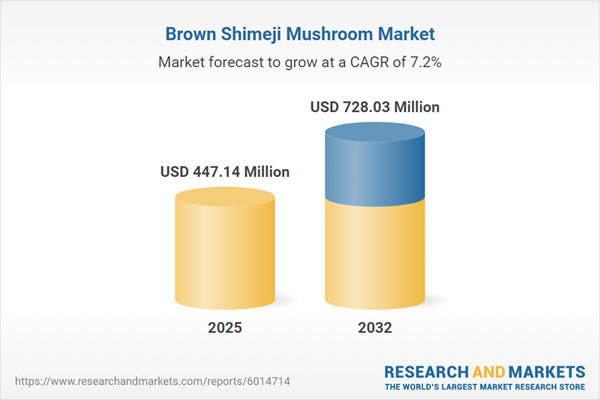Speak directly to the analyst to clarify any post sales queries you may have.
The Brown Shimeji Mushroom Market is undergoing significant transformation as sustainability, innovation, and improved efficiency shape enterprise strategies globally. Senior decision-makers are seeking forward-looking solutions that address fast-evolving consumer needs while leveraging next-generation technologies and robust supply frameworks.
Market Snapshot: Brown Shimeji Mushroom Market Size and Trajectory
The global Brown Shimeji Mushroom Market reached a valuation of USD 418.31 million in 2024, with projections indicating expansion to USD 447.14 million by 2025 and a trajectory toward USD 728.03 million by 2032. This growth is propelled by a 7.17% CAGR, underpinned by investments in controlled-environment agriculture and heightened interest in specialty mushrooms. Organizations benefit from rising consumer health priorities, while foodservice, retail, and nutraceutical channels drive ongoing innovation. Shifts in consumer behavior and regulatory priorities are motivating stakeholders to develop nutrient-rich products and redefine strategies for established and high-growth markets.
Scope & Segmentation: Brown Shimeji Mushroom Market
This report delivers actionable intelligence, supporting strategic decisions for market entry, expansion, and resource allocation:
- Product Types: Fresh, dried, and frozen Brown Shimeji mushrooms enable companies to diversify offerings tailored to culinary, retail, and wellness-oriented markets.
- Packaging Types: Bulk packaging supports foodservice and hospitality segments, while consumer-ready formats serve both specialty and mainstream retail distribution.
- Categories: Conventional and organic options allow organizations to target both sustainability mandates and consumer-driven preferences for traceable, clean-label foods.
- Distribution Channels: Offline networks are complemented by increasing use of digital direct channels, broadening reach and supporting adaptive sales strategies across regions and demographics.
- Applications: Brown Shimeji mushrooms are integrated into culinary products and nutraceuticals, aligning with consumer wellness trends and ensuring broad product development potential.
- Regions Covered: Insights cover Americas, Europe, Middle East & Africa, and Asia-Pacific, equipping leaders to address unique supply chain considerations and regional strategy requirements.
- Key Companies: Includes benchmarking against Bombay Farming Co., Hokuto Corporation, Hokto Kinoko Company, Kaze Living, Maya Mushrooms Ltd, Merit Mushrooms, Mycopia Mushrooms, Planet Mushroom, Shaanxi Winfun Industrial, Shanghai Finc Bio-tech, Shroomin, Smithy Mushrooms, South Mill Champs, Suzuki Farm, and Yin N Yang Farms Pvt. Ltd. to inform peer analysis and strategic partnerships.
Key Takeaways: Actionable Insights for the Brown Shimeji Mushroom Market
- Strengthen brand positioning by prioritizing advanced substrate innovations and integrating renewable energy, ensuring alignment with evolving sustainability targets across international markets.
- Invest in vertical farming and precision climate control to optimize output stability, meet high product quality standards, and satisfy commercial buyers across diverse industries.
- Implement supply chain traceability technologies, such as blockchain and RFID, to increase transparency, reinforce compliance, and match the demand for traceable, clean-label specialty ingredients.
- Build collaborative relationships among growers, distributors, and retailers to quickly introduce value-added products and respond to shifts in consumer demands and regulations.
- Develop flexible, region-specific strategies to address logistics and compliance, with a focus on high-growth Asian markets and operational reliability in North America and Europe.
- Maintain a strong focus on research and development, along with supply-side collaborations, to enhance resilience and capture opportunities in both foodservice and health-focused product applications.
Tariff Impact: United States Market Dynamics
Forthcoming tariff adjustments in 2025 are prompting U.S. specialty mushroom producers to refine sourcing and pricing models. Key strategies include building long-term supplier partnerships, expanding domestic production, and diversifying product lines to reduce vulnerability. Enhanced cold-chain logistics and regional production frameworks are also being utilized to strengthen industry resilience and maintain profitability during regulatory change.
Methodology & Data Sources
This analysis leverages direct feedback from industry professionals and draws on an extensive literature review. Segmentation frameworks and modeling approaches are independently validated, providing trusted and practical market intelligence to support strategic executive decisions within the Brown Shimeji Mushroom Market.
Why This Report Matters
- Decision-makers access reliable insights for identifying innovation opportunities and optimizing operations in line with global sector trends.
- The findings facilitate rapid adaptation to evolving regulatory landscapes, digital transformation, and supply chain optimization across multiple markets.
- Comprehensive benchmarking and best-practice assessments help organizations prepare for market volatility and emerging industry shifts.
Conclusion
An industry-wide emphasis on sustainability, advanced production technologies, and collaborative supply chain partnerships is broadening the market reach of Brown Shimeji mushrooms, driving resilience and expansion across evolving global sectors.
Additional Product Information:
- Purchase of this report includes 1 year online access with quarterly updates.
- This report can be updated on request. Please contact our Customer Experience team using the Ask a Question widget on our website.
Table of Contents
3. Executive Summary
4. Market Overview
7. Cumulative Impact of Artificial Intelligence 2025
Companies Mentioned
The companies profiled in this Brown Shimeji Mushroom market report include:- Bombay Farming Co.
- Hokuto Corporation
- Hokto Kinoko Company
- Kaze Living
- Maya Mushrooms Ltd
- Merit Mushrooms
- Mycopia Mushrooms, Inc.
- Planet Mushroom
- Shaanxi Winfun Industrial Co., Ltd
- Shanghai Finc Bio-tech. Co., Ltd.
- Shroomin
- Smithy Mushrooms
- South Mill Champs
- Suzuki Farm
- Yin N Yang Farms Pvt. Ltd.
Table Information
| Report Attribute | Details |
|---|---|
| No. of Pages | 193 |
| Published | November 2025 |
| Forecast Period | 2025 - 2032 |
| Estimated Market Value ( USD | $ 447.14 Million |
| Forecasted Market Value ( USD | $ 728.03 Million |
| Compound Annual Growth Rate | 7.1% |
| Regions Covered | Global |
| No. of Companies Mentioned | 16 |









